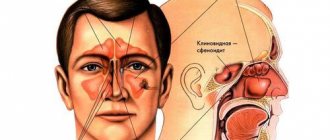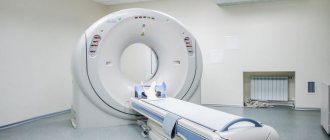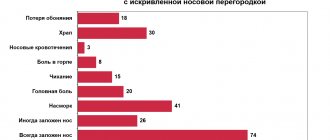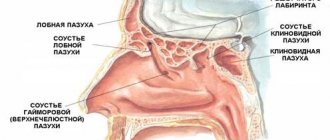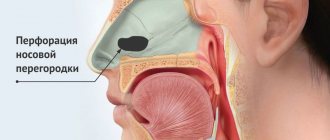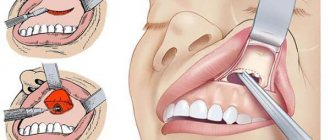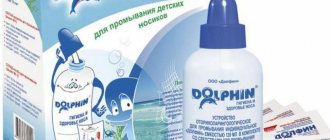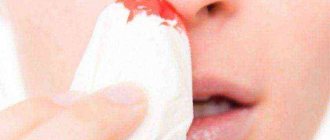Laser vasotomy of the nasal turbinates
You should know! Laser vasotomy is the treatment of the nasal mucosa with a laser beam.
Such a beam cauterizes and evaporates pathological cells formed during the development of inflammatory processes (adhesions, dead tissue, areas of the mucous membrane destroyed during inflammation).
Such formations occur mainly with vasomotor rhinitis.
And when they are evaporated, the likelihood of further infection of tissues and the occurrence of additional diseases is reduced .
In cases where rhinitis can no longer be cured with medication, laser treatment is 90% effective .
At the same time, 10% of relatively unsuccessful procedures are not hopeless cases: with repeated procedures, rhinitis can most often be eliminated.
When exposed to a narrowly focused laser beam, metabolic processes and blood circulation are stimulated in the capillaries and vessels of the mucous membrane of the nasal passages, but the integrity of its covering is not compromised.
It is worth noting! As a result of laser therapy, the patency of the nasal passages increases, swelling subsides, and respiratory functions are restored.
Depending on the goals set, the surgeon who performs the operation adjusts the power of the laser pulse, which can have both a stimulating (preventive) and therapeutic effect.
In areas treated in this way, a coagulation layer is formed.
This is a film that protects the affected areas from the penetration of external irritants and pathogens and prevents the development of bleeding , and the tissues under the protective layer regenerate faster.
Methods for performing vasotomy of the inferior turbinates
The essence of the operation is to dissect (or destroy) the vessels without damaging the nasal mucosa. The vessels become smaller, the swelling of the nasal mucosa goes away and the nasal turbinates decrease in volume, opening the way for the free passage of air through the nose.
This operation can be performed using different methods: traditionally using a raspatory, electrocoagulator, surgical laser, radio wave devices, ultrasound.
| Operation method | How is the operation performed? | Advantages | Flaws |
| Electrocoagulation (electrocautery, galvanocautic) | An electrode heated by direct current is inserted into the nasal concha. Due to the contact of the hot electrode with the tissues, they are cauterized. |
|
|
| Vasotomy using traditional surgical instruments: raspatory and scalpel | An incision is made with a scalpel into which a raspatory (a flat, straight metal instrument) is inserted. The vessels along the entire length of the nasal concha are mechanically destroyed. |
|
|
| Laser coagulation (laser vasotomy, laser reduction) | The conductor of the laser device is inserted under the mucous membrane of the nasal concha. Heating and destruction of blood vessels occurs under the influence of laser energy. |
|
|
| Radio wave vasotomy (radiofrequency coagulation, radio wave destruction, radio wave reduction) | High frequency alternating current operates, generating radio waves. The vasotomy attachment is a bipolar electrode in the form of a fork, which the surgeon inserts under the mucous membrane of the nasal concha. The passage of radio waves through tissue causes it to heat up and destroy. |
|
|
| Ultrasonic disintegration (ultrasonic destruction, ultrasonic vasotomy) | Ultrasound destruction of tissue. |
|
|
Doctors at our clinic perform submucosal vasotomy using radio wave or laser methods, since these methods are currently the most effective and safe. For radio wave vasotomy, an ELLMAN (Surgitron EMC) device with a bipolar fork-shaped attachment is used.
This attachment is convenient. It allows you to carefully pass under the mucous membrane in the vascular zone, while avoiding bleeding.
Danger of pathologies
Laser therapy for rhinitis is necessary to exclude the development of more serious diseases .
Keep in mind! If such treatment is not carried out in a timely manner, the following disorders and diseases may occur against the background of pathologies of the nasal turbinates:
- destructive processes in the structures and tissues of the middle ear, leading to obstruction of the auditory tubes;
- chronic oxygen starvation;
- hypertension developing against the background of chronic spasms in the nasal passages;
- damage to ciliated epithelial cells;
- development of chronic dry rhinitis.
In this case, not only the pathologies themselves are dangerous, but also their treatment using vasoconstrictors .
Over time, they also lead to such consequences if the duration of treatment is exceeded.
Indications for surgery
Stay up to date! Laser destruction is prescribed in the following situations:
- Congenital or acquired deformities of the nasal septum , leading to blockage of the nasal passages.
- Chronic rhinitis of any origin.
- Complicated and uncomplicated epithelial hyperplasia .
- The development of various pathological processes against the background of addiction to nasal drops as a result of addiction.
- Hypertrophy of the nasal mucosa.
Pathological processes can develop in one nasal passage or be bilateral.
Accordingly, laser excision can be local and performed only on one side of the nose, if no problems are observed in the other passage .
Pathology of the inferior turbinates is the main cause of chronic nasal congestion
One of the main causes of chronic nasal congestion is the pathology of the inferior turbinates.
However, today there is no agreement among experts on solving this problem. The initial method of choice is mainly pharmacological treatment. In many cases, nasal topical steroids, antihistamines, and decongestants provide good results. Patients who do not respond to this treatment are usually prescribed surgical reduction of the turbinates.
Since the last quarter of the 19th century, at least 13 different technologies have been introduced. Some of them have already been abandoned, while others are still in use or have been reintroduced. There is, however, considerable disagreement about the merits of various technologies (Jackson and Koch, 1999).
Some authors consider conchotomy as the most acceptable method of treatment, while others condemn it as too aggressive and irreversibly destructive. Another controversial technology is laser treatment. Although a number of authors have recently advocated this technique, many rhinologists do not approve of it, since the laser destroys the mucous membrane and consequently reduces its functioning.
Contraindications
Note! The procedure is not performed if the patient is diagnosed with certain diseases:
- diabetes;
- incurable blood diseases that prevent blood clotting;
- renal failure at the stage of decompensation;
- any infectious diseases in the acute stage ;
- liver failure;
- serious heart disease;
- ulcerative and atrophic pathologies of the mucous membrane of the nasal passages .
A relative contraindication for women is the menstrual period, since at this time hormonal levels are disrupted, which can lead to the development of a number of side effects.
Postoperative period
To minimize the risk of complications, you should strictly follow your doctor's instructions.
The appearance of swelling, thick copious discharge, and crusts is an absolutely normal phenomenon. If the treatment was carried out using a minimally invasive method, then the condition should normalize by about 4 days. If we are talking about surgical intervention, then recovery will take at least a month, and only then the final results are assessed.
In some cases, repeat turbinate vasotomy may be required.
A common complication is the addition of infection. Atrophy of the mucous membrane may also be observed, manifested by unpleasant sensations and dryness.
In the absence of proper care of the nasal cavity after surgery, the formation of synechiae is possible - and this is an indication for repeated surgery. Unsuccessful results may require repeat intervention.
The rehabilitation period after vasotomy lasts about a week. At this time, mucus and crusts are discharged, regeneration and complete restoration of the functions of the nasal mucosa occurs. In the vast majority of cases, after surgery there is a rapid restoration of nasal breathing; relapses and complications are quite rare.
There are a number of restrictions that should be observed during the rehabilitation period after submucosal vasotomy
- Excessive physical activity is prohibited (especially sudden tilts of the head and torso);
- It is extremely undesirable to take alcoholic beverages during this period;
- inadmissibility of staying in hot places (baths, saunas, steam rooms).
An important component of postoperative rehabilitation are measures that promote regeneration (restoration) of the mucous membrane. On the 3-4th day after surgery, a protective layer forms on the operated area, which is a fibrinous-necrotic plaque that has high adhesive (gluing) properties.
This factor may contribute to the development of adhesions between the operated surface of the inferior turbinate and the mucous membrane of the nasal septum. As a result, the nasal cavity requires thorough cleansing, usually performed by an otolaryngologist. At home, special nasal sprays and drops are used to cleanse the mucous membrane and accelerate the regenerative process; topical use of peach or olive oil gives good results.
To eliminate postoperative swelling of the mucous membrane, desensitizing (antihistamine) drugs are used; the use of vasoconstrictor drugs during this period is strictly prohibited, due to the risk of relapse of the disease. Nasal congestion, as a rule, lasts no more than 3-4 days, followed by a gradual decrease in swelling of the mucous membrane and restoration of full nasal breathing.
Most techniques are available on an outpatient basis. Therefore, the patient, once at home after the operation, must independently monitor his condition and respond to alarming symptoms:
- temperature rise of more than 38 degrees Celsius;
- chills and fever;
- severe pain in the nasal cavity.
These symptoms indicate the development of inflammation against the background of an infectious infection. Inflammation can develop regardless of what technique was used for vasotomy of the nasal turbinates: laser, radio wave, surgical or any other. Any surgical intervention leads to a decrease in the body's protective functions. And even if the operation was performed using a minimally invasive method, if you have the symptoms listed above, you should consult a doctor.
Submucosal vasotomy of the inferior conchae does not pose a danger to the patient and very rarely leads to complications. Normal post-operative symptoms include thick mucus from the nose, crusting and swelling. Among the undesirable consequences are:
- atrophy of the mucous membrane - if important epithelial cells have been damaged, a process will begin that is the opposite of tissue proliferation;
- loss of smell is an unpleasant temporary symptom;
- relapse;
- adhesions are a condition requiring repeated surgical correction.
The most serious, but quite rare complication is tissue necrosis. If the surgeon has removed too many vessels and the blood supply to the mucosa is disrupted, healthy tissue will begin to starve and die.
Sinusitis
Temperature
Preparation for laser vasotomy
There is no special preparation for laser therapy for rhinitis.
Important! Patients are required to avoid alcohol and blood thinning medications 5-7 days before the procedure.
Women should not use decorative cosmetics for three days before surgery . Additionally, an examination may be prescribed to detect infectious diseases.
If there are no obstacles to performing a vasotomy, the day of the operation is set, and the patient is explained the specifics of its implementation.
Existing contraindications
Despite the fact that such an operation is not associated with significant difficulties and can be performed even on an outpatient basis, this method of treatment is not suitable for everyone. In some cases, submucosal vasotomy is strictly contraindicated. Such cases include the following:
- During pregnancy and breastfeeding - it is recommended to postpone the trip to the clinic until the end of the lactation period, especially since this method is not an emergency;
- The presence of advanced and acute infectious disorders;
- Problems of various types with the upper respiratory tract - in the presence of infections such as laryngitis or sinusitis, the intervention should be postponed until recovery;
- Insufficiency of platelets in human blood - hemorrhagic shock is possible during treatment;
- Various mental disorders.
Progress of the operation
The operation is carried out in the following sequence:
- The patient sits in the surgical chair and puts on protective glasses to prevent accidental exposure of the laser to the organs of vision.
- The pathological areas that will be affected by the laser are determined.
- The surgeon places a disinfected or disposable light guide – an attachment – on the laser device. It is partially inserted into the nasal passages and sets the laser beam in the required direction.
- Each area is treated with a beam for one minute . Typically, the laser covers several pathogenic zones - on average there are from one or two to 15-16. Accordingly, the procedure lasts no more than fifteen minutes .
Reference! Treatment is carried out in a course consisting of an average of ten to twelve procedures (depending on the severity of mucosal lesions).
In case of severe chronic rhinitis, it is possible to carry out three courses, between which intervals of two and three months are maintained.
The procedure is performed on an outpatient basis, without anesthesia, and does not require further hospitalization .
Advantages
Treatment of rhinitis using laser has several advantages:
- no side effects or severe consequences;
- the patient does not need to limit himself in his usual lifestyle after the procedure ;
- rapid treatment of pathological areas of the mucosa;
- creating a sterile space in the nasal passages, due to which the tissues heal faster in the absence of exposure to pathogenic microflora;
- no pain;
- high efficiency of the method.
Rehabilitation period
Need to know! Laser treatment requires compliance with simple rules during the rehabilitation period.
During the first week, any physical activity is prohibited - from work to sports.
also not recommended to visit saunas and baths or drink alcohol.
This can cause increased blood flow and increased blood pressure.
As a result of this, areas of the mucous membrane that have not fully healed may begin to bleed.
This phenomenon in itself is not dangerous, but bleeding will slow down the healing process.
vasoconstrictor nasal medications were used for treatment before surgery they are discontinued for the rehabilitation period .
It is possible to use only healing sprays prescribed by the attending physician.
Remember! In the first three days after a vasotomy, breathing may seem difficult and there will be mild discomfort in the nose.
These are normal symptoms indicating tissue healing, and after three days breathing returns to normal.
Possible consequences
Complications after laser treatment are extremely rare and in most cases are temporary.
The most dangerous thing is inflammation of the nasal passages and mucous membranes.
This only happens if there is a violation on the part of a specialist (undisinfected instrument, too long laser exposure, accidental mechanical damage to the nasal passages with a light guide).
When the procedure is repeated in case of complicated rhinitis, breathing difficulties may occur .
You should know! In all cases, a partial loss of smell may be temporarily observed, but this is a temporary phenomenon due to swelling of the mucous membrane after surgery.
This consequence does not occur in everyone, but it is possible with increased tissue sensitivity.
Reviews
“ Two years ago I suffered from a complex form of rhinitis , which I treated with drops.
I used them for several weeks because it was impossible to breathe without them, and unfortunately I missed the moment when it was still possible to safely stop taking the drug .
As a result, rhinitis became chronic , and the ENT specialist could not offer anything other than surgery .
After laser vasotomy, the problem disappeared , and now I can breathe freely without droplets.”
Mikhail Tushin, Rossosh.
“From my youth, I was diagnosed with hypertrophic rhinitis , which greatly ruined my life. Treatment with drops, ointments, herbs - none of this helped.
I learned about laser treatment by chance from a flyer for one of the clinics. This was my last hope, and it came true.
Laser vasotomy helped restore breathing and get rid of a chronic runny nose , and the procedure itself did not cause any unpleasant or painful sensations.”
Gennady Zhitov, Belgorod.
Types of vasotomy: how is the operation performed?
And although classical surgical operations are increasingly inferior to less traumatic minimally invasive interventions, it is impossible to say for sure which treatment method is the best. The optimal type of treatment is selected taking into account individual characteristics.
Open surgery is a classic option that involves the use of techniques such as:
- Lateropexy. The nasal concha moves to the wall of the nostril and is fixed. This makes breathing easier by increasing the diameter of the airways.
- Submucosa. During the operation, the mucous membrane is separated and the submucosal vascular plexuses are destroyed.
- Conchoplasty. During the operation, part of the nasal concha and the mucous membrane of this area are resected.
The operation can be performed either under general anesthesia or using only local anesthesia.
Turbinoplasty
A radical treatment method that involves removing a fragment of the shell. It is quite traumatic, and therefore the recovery period is longer compared to minimally invasive techniques. The operation must be performed by an experienced specialist - due to the high morbidity, complications are not uncommon.
This is also a surgical method that involves the use of a shaver, which is a rotating knife connected to an electric suction device. With the help of a shaver, all of the above methods can be performed.
Laser nasal vasotomy involves removing the choroid plexuses using a laser.
This is a popular procedure - it is simple to perform, low-traumatic, the recovery period is short, and complications are rare. The cost of laser vasotomy of the nasal turbinates is relatively low.
Radio wave vasotomy is another modern treatment method, also called radio wave destruction. Its essence lies in the coagulation of blood vessels - this is how the problem of vasomotor rhinitis and other chronic diseases of the nose is quickly and painlessly solved. Radio wave vasotomy is receiving positive reviews.
It is one of the methods of radio wave surgery. Coblation, as this method is called, helps to heat tissue up to 70 degrees. The method combines high efficiency and low trauma.
The method is based on gluing the walls of mucous vessels, thereby reducing swelling and restoring breathing. The method is good for minor hypertrophic changes, but in more severe cases other methods are recommended.
Cryodestruction
The mucous membrane is treated with a cryoprobe, as a result of which the swelling of the problematic mucous membrane goes away.
Electrocautery
The essence is to cauterize tissues, which subsequently become scarred and compress the choroid plexuses, which allows breathing to be restored. Today, the procedure is performed less and less often, because many more modern and less traumatic types of treatment have appeared that do not injure surrounding healthy tissue.
